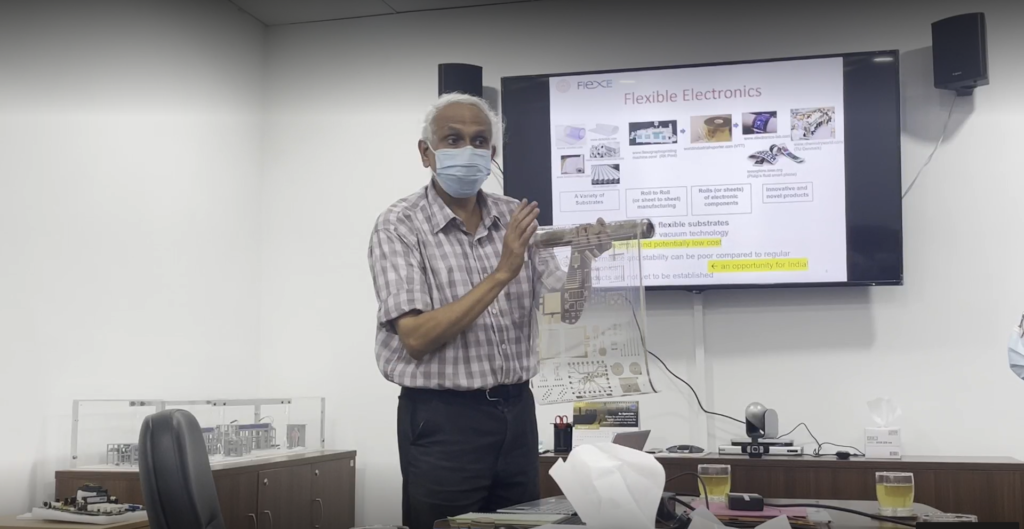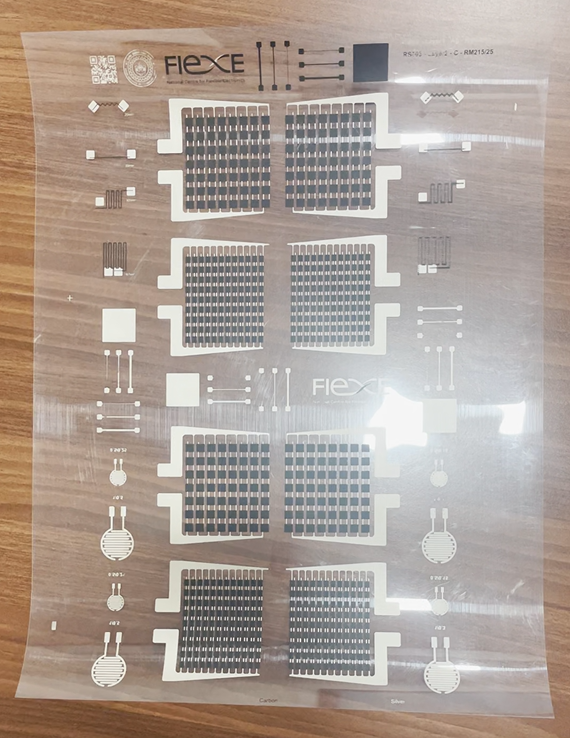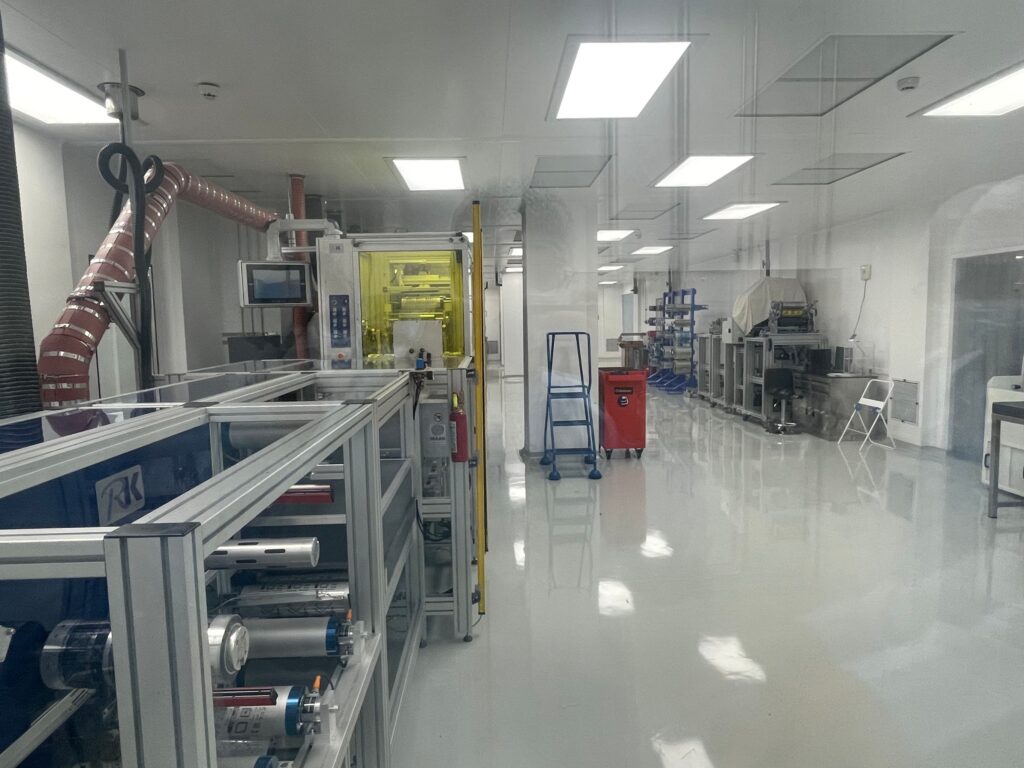Early on, at the start of the millennia, Mr Satish Kaura, an alumnus of our institute, was running a business that manufactured most of the cathode ray tubes for displays in the country. However, he had the foresight to realise that the industry would need to be nimble and change and evolve in the coming years. The inception of the Flexible Electronics ecosystem at IIT Kanpur was set in motion with the Samtel Centre for Display Technologies coming up under the guidance and leadership of Prof. K. R. Sarma, Prof. R. Sharan and a team of enthusiastic faculty members from multiple departments from the institute.
While this facilitated and enhanced academia-industry collaboration, there were still challenges faced to translate the research ideas into manufacturing and making the ideations commercially viable. The National Centre for Flexible Electronics (Flex-E Centre), built as a centre of excellence, came about to address this need. The Flex-E Centre is home to the intersection of industrial ideation, manufacturing and entrepreneurial ventures engaging with corporate pioneers and academicians, along with the support of the Ministry of Electronics and Information Technology (MeitY) of the Government of India and the Institute administration. With more than 20 member industries and NDAs with over 125 organisations, the Flex-E Centre stands tall in the academic area as a place of innovation and science. To cover what goes on at this flagship centre on our campus, correspondents from Vox Populi reached out to Prof. Sundar Kumar Iyer, the current coordinator of the centre and visited the facility to get a glimpse of the day-to-day happenings there.

Projects
The Flex-E Centre building is a modern state-of-the-art facility that is home to more than 10 ongoing projects spanning various topics. The core group leading this centre consists of faculty members as mentors, a chief operating officer (COO) and subject expert team leaders. They are ably supported in carrying out the activities by several research, maintenance and office staff. Many of the researchers involved with the centre have international and international experience. Currently, the activities in the facility are funded by MeitY, the strategic sector (eg. Indian Space Research Organisation ISRO and the Defence Research and Development Organisation, DRDO) and industrial partners. The annual operational costs for the centre add up to an amount of 8 – 10 crores.
Support Labs
We then visited the support labs, starting with the Wet lab, which is where inks are developed for printing electronics on various flexible substrates, such as plastics, paper, cloth and metal foils. The in-house develops inks, often custom built on request of partner industries and ongoing projects. These inks along with some commercially available ink provide the basic building block of flexible and printed electronic products.
At the other end of the prototype and product development is the Systems Lab. Here the innovative printed components developed are giving a useful practical product form, often in conjunction with traditional electronics and already available articles. In this lab, we got to see some novel applications developed by the centre which address some of the common-place problems faced by the average person in society. The lab has many tools to facilitate its work, including circuit magnifiers, equipment to integrate chips on printed circuit boards, a 3D printer, circuit testing equipment and the like.
The various flexible electronic components developed are often tested and refined in some of the other labs which we viewed from the outside – the Electrical Lab, Optics Lab, Materials Lab and Sensors Lab.
Products
We got a glimpse of some of the products developed at the centre by the different groups. The problems that the products address are practical and often typically Indian in their context.
One such product, which is built upon investigative research carried out earlier at IIT Kanpur, is about verifying milk quality (Prof. Siddhartha Panda, Dr Devendra Mourya and team). Milk in India is often procured by cooperatives from multiple households. Contamination from any one source will contaminate the whole collection. This project aims to detect many of the common contaminants quickly, effectively and at a low cost so that contaminated milk may be identified just before it is received.
We got to view some innovative applications in healthcare developed at the centre. Prof. Mazhari, Mr Biswanath Panda and the team have developed a few versions of temperature monitoring devices that were deployed during the pandemic within our institute. Another innovation by this team is detecting the level of liquid in intravenous (IV) fluid bottles used in medical facilities. This innovation can sensitise the nurse electronically or by an alarm, once the level liquid comes close to finishing. The innovative labels used for this prototype were built with in-house ink and printed in the roll-to-roll machine. This product when deployed will greatly aid in giving better treatment to patients and ease the stress on caregivers.
Warm hug is a product developed by multiple teams at the centre. For this product, heaters are printed with in-house developed carbon inks and then integrated into jackets. The heaters are self-limiting at the maximum temperature they can reach and hence are safe for regular use. These jackets are primarily being developed to assist soldiers placed at higher altitudes to stay warm while using minimal electrical power – equivalent to the order of which we store in our phone batteries – to heat up the jacket. The initial prototypes were tried out by SIS guards at our campus in the Kanpur winters. The ITBP has been in talks with Flex-E Centre to test and assess deployment in higher altitudes.

Another area of innovation is flexible displays and lighting with organic light-emitting diode (OLED) technology. Prof. Monica Katiyar, Dr Muralidharan Balasubramanian and the team are exploring a variety of applications, including in the automobile sections. Similarly, Prof. Deepak Gupta, Dr Ashutosh Tripathi and the team are involved in many innovative projects with DRDO and ISRO using thin film transistor (TFT) technology and other devices for deployment in submarines and antennas respectively. Prof. Anshu Gaur is looking into using amorphous metal-oxide and metal-oxynitride semiconductors to build flexible electronic devices. Prof. Iyer’s team is developing flexible solar modules on paper substrates.
Flex-E Centre has spawned a couple of start-up ventures. One such start-up is Checko from Prof. Deepak Gupta’s team, which prints PUFs (Physically Unclonable Features). The unique ID of the PUF can be verified for authenticity by using a pre-downloaded app on a smartphone. The product is currently used by Madhya Pradesh Beej Nigam and the Delhi Excise Department, besides many private companies that want to ensure their brand protection.
The second start-up is mentored by the ink team led by Prof. Y.N. Mohapatra and Dr Ashish Gupta called Likhotronics. The pens this start-up has developed have different conductive inks which are supplied with a do-it-yourself (DIY) kit. By drawing lines with these pens on paper, one can build circuits which could be used to help children learn concepts in electronics. This is expected to have an impact on education – teaching and examining electrical circuit concepts – in the coming years.
The strength of the centre, we were told, is its ability to reach out to the industry and work with them in developing many relevant solutions with it. This process is ably supported by the COO Dr Sudheer Kumar along with the individual faculty members and other team members involved.

The Flex-E Centre is a multidisciplinary centre institute, where research results from various disciplines – electronics, materials, chemistry, physics, chemical engineering, bio-engineering, etc. are harnessed for addressing the needs of society. Such a dynamic centre of excellence, with cutting-edge innovation and technological advancements coming out of it, is a matter of immense pride not just for our Institute but for our nation as well. Keep an eye out for novel ideas and technologies from this engineering and science centre!
We genuinely thank Prof. Sundar Kumar Iyer for his great zeal and support in helping us write this article.
Written by: Khush Khandelwal, Rahul Jha, Mridul Pandey, Zainab Fatima
Edited by: Sanika Gumaste, S. Pradeep

No Comments
Leave a comment Cancel